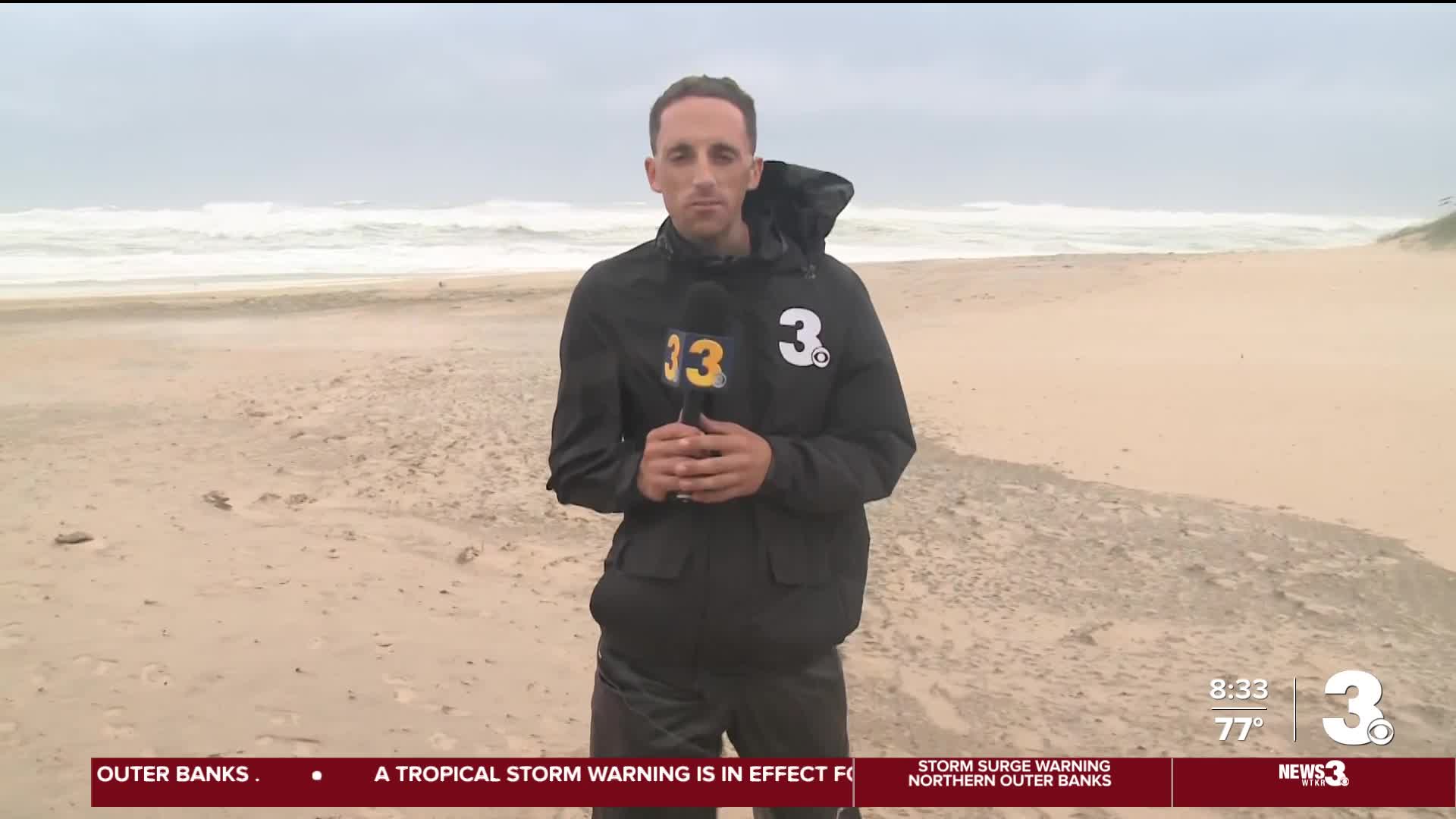RODANTHE, N.C. (AP) — Hurricane Erin battered North Carolina’s Outer Banks with strong winds and waves that flooded part of the main highway, damaged a waterside motel and swirled under beachfront homes as the monster-sized storm slowly began to move away from the East Coast on Thursday.
Watch: Hurricane Erin is off the coast of North Carolina with tropical storm warnings in effect
Forecasters predict the storm will gradually weaken over the next few days while turning farther out to sea.
Tropical storm conditions were in effect over parts of the Outer Banks and the coast of Virginia, the National Hurricane Center in Miami said. In Bermuda, residents and tourists were told to stay out of the water with rough seas expected through Friday.
There was flooding along part of the North Carolina and mid-Atlantic coasts, the center said Thursday morning. Authorities warned that the largest swells would continue to whip up life-threatening rip currents from the Carolinas to New England.
Watch: Rough surf, heavy winds sweep the Outer Banks
Big waves push water over roads
As Erin's outer bands brushed the Outer Banks, waves broke through dunes on Hatteras and Ocracoke Islands and swamped the main route connecting the barrier islands. Parts of Highway 12 remained closed Thursday, and Ocracoke's connection to its ferry terminal was cut off.
Melinda Meadows, property manager at the Cape Hatteras Motel in Buxton, told WRAL-TV that a door was ripped off a townhouse and some walls were knocked out.
Farther north, on Jennette’s Pier in Nags Head, where sustained winds reached 45 mph (72 kph) early Thursday, dozens who rode out the storm were taking photos of the huge waves crashing into the structure amid the driving rain.
“This is nature at her best,” David Alan Harvey of Nags Head said Thursday morning. “I love this. I love these storms.”
A few feet away, Sebastian Kettner, who lives in Clayton, was casting a line for red fish.
“Where there's water, there's fish,” he said as the wind howled. “And there's a lot of water here.”
Beaches off-limits along the coast
Beaches were closed to swimming Thursday in New York City, but that didn't stop more than a dozen surfers from taking on the waves at Rockaway Beach in Queens. Other spots in New Jersey, Maryland and Delaware also were temporarily off-limits. Widespread, moderate coastal flooding was forecast for low-lying areas of Long Island and parts of New York City.
Off Massachusetts, Nantucket Island could see waves of more than 10 feet (3 meters) this week.
Bob Oravec, a National Weather Service forecaster, said that even if someone thinks they know how to handle a rip current, it’s not safe.
Huge waves cause coastal flooding
Coastal flooding and erosion was a big worry in many beachfront communities. In North Carolina, waves were estimated as high as 18 feet (5.5 meters) Thursday morning, according to local weather reports.
Dozens of beach homes already worn down from chronic erosion and protective dunes were at risk, said David Hallac, superintendent of the Cape Hatteras National Seashore.
Most residents decided to stay despite evacuations ordered on Hatteras and Ocracoke Islands, which are increasingly vulnerable to storm surges.
The Hatteras Island Rescue Squad, a volunteer group based in Buxton, said it received no calls for rescues Wednesday night through Thursday morning.
Erin remains a large hurricane as it heads out to sea
The storm has fluctuated in intensity since first forming nearly a week ago, but it's still unusually large, stretching across more than 600 miles (965 kilometers) — twice as big as the average hurricane.
It remained a Category 2 storm late Thursday morning with maximum sustained winds around 100 mph (160 kph), the hurricane center said. Erin was about 260 miles (420 kilometers) east of Cape Hatteras and moving away from the East Coast.
The hurricane center was also watching two tropical disturbances far out in the Atlantic that could develop into named storms in the coming days. With thousands of miles of warm ocean water, hurricanes known as Cape Verde storms are some of the most dangerous that threaten North America.
Climate scientists say Atlantic hurricanes are now much more likely to rapidly intensify into powerful and catastrophic storms, fueled by warmer oceans.
___
Seewer reported from Toledo, Ohio. Associated Press journalists Tammy Webber in Fenton, Michigan; Jeffrey Collins in Columbia, South Carolina; Kathy McCormack in Concord, New Hampshire; and Julie Walker in New York contributed to this report.







